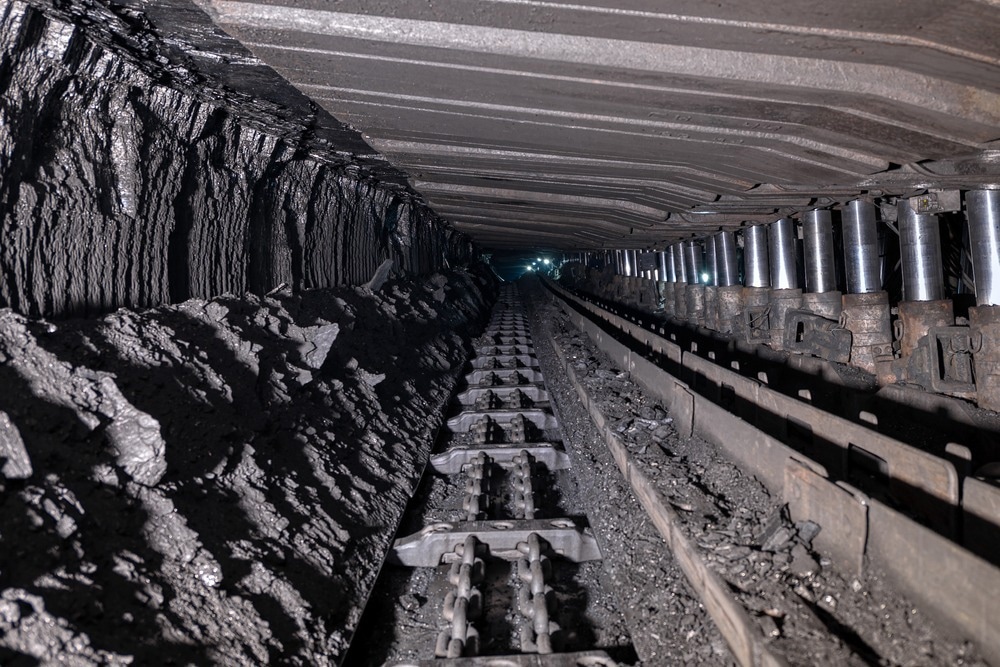In a recent article published in the journal Scientific Reports, researchers presented a novel mining technique titled the short-wall roadway backfill mining (SRBM) method. The technique aims to enhance the sustainability and safety of underground coal mining operations.

Image Credit: Nordroden/Shutterstock.com
Background
Historically, underground mining methods such as room-and-pillar and long-wall caving have dominated coal extraction. While effective in terms of resource recovery, these methods often cause significant surface subsidence and disturb overlying strata, leading to structural damage to buildings and farmland.
Long-wall caving, effective for thick and gently inclined seams, tends to induce large-scale roof failure and surface deformation. To address these issues, backfill mining methods, particularly long-wall and supported techniques, have been developed.
These methods involve refilling excavated voids with backfill materials such as solid waste, which helps stabilize the overlying strata and reduce surface subsidence. However, these techniques have limitations, including complexities in backfill material properties, operation synchronization, and the rapid development of large roof spaces requiring high early strength of backfill.
Prior research has also recognized the importance of backfill parameters such as cohesion and elastic modulus in maintaining stability. Nonetheless, a comprehensive, generalized framework for designing safe, environmentally conscious backfill mining operations remains lacking. This creates a gap that the current study aims to bridge by developing a systematic SRBM method complemented by analytical and numerical modeling.
The Current Study
The research methodology encompasses multiple facets, beginning with the design of the SRBM system tailored for complex geological environments. The method segments the mining area into sections with designated working faces based on the short-wall mining setup, connected by crosscuts to ensure continuous resource recovery and waste disposal. These crosscuts also facilitate the logistical coordination between mining and backfilling operations, forming a cyclic process where coal extraction proceeds in tandem with immediate backfill application, mainly using gangue and fly ash.
The layout ensures that post-mining, the voids are promptly filled to stabilize the roof and prevent subsidence.
A central component of the study involves developing a mechanical model to analyze roof stability under various conditions. The model focuses on the tensile stress within the roof strata and its relation to mining parameters such as mining height, face length, and backfill mechanical properties, notably elastic modulus and cohesion.
To accurately simulate the stress and deformation evolution, the authors perform three-dimensional numerical analyses using finite element methods, considering both the mining process and the backfill's mechanical behavior. These simulations help predict stress distributions and identify critical factors influencing roof fracture or failure.
Field experiments then validate the models, with real-time stress and surface deformation monitoring during mining operations. Laboratory tests determine backfill material properties, such as slump and elastic modulus, informing the simulations.
Results and Discussion
The results from numerical simulations and field monitoring demonstrate that the elastic modulus of the backfill material critically influences roof stability.
As the elastic modulus increases, tensile stresses within the roof decrease significantly, leading to a lower likelihood of fracture initiation. Specifically, when the elastic modulus shifts from 0.45 to 0.5 GPa, the maximum tensile stress reduces by approximately 2.38 MPa, indicating improved stability. This suggests that selecting or designing backfill materials with higher elastic moduli can effectively mitigate roof strain and enhance safety.
The study reveals that mining parameters such as face length and mining height directly affect the distribution of stresses within the strata. Longer face lengths and increased mining heights tend to elevate tensile stresses, raising the risk of roof failure.
The elastic modulus of the backfill exerts the greatest influence among the parameters studied, emphasizing the importance of backfill property optimization. Sensitivity analyses corroborate these findings, indicating that prioritizing backfill mechanical strength, particularly elastic modulus, constitutes a key strategy for controlling roof stress.
Conclusion
The study successfully introduces the short-wall roadway backfill mining method as a viable, sustainable alternative to conventional mining techniques, with significant benefits in controlling surface subsidence and utilizing solid wastes. By developing an analytical model grounded in tensile stress and validating it through numerical simulations and field monitoring, the research provides valuable insights into the mechanical behavior of the overburden strata under backfill conditions. The findings clearly demonstrate that the elastic modulus of backfill materials plays a dominant role in maintaining roof stability and minimizing deformation. Strategic optimization of mining parameters, including face length and mining height, further enhances safety and efficiency. The practical application in a Chinese coal mine exemplifies the method’s feasibility and effectiveness, paving the way for broader adoption.
The research underscores the importance of selecting appropriate backfill materials and tailoring mining parameters to specific geological contexts. Future studies are recommended to incorporate more heterogeneous geological models and explore the long-term stability of backfilled sites, ensuring that the method’s advantages are sustained over operational lifespans.
Source:
Zhang L., Pan J., et al. (2025). Short-wall roadway backfill method for sustainable mining. Scientific Reports 15, 19905. DOI: 10.1038/s41598-025-96598-z, https://www.nature.com/articles/s41598-025-96598-z